Children of Paris: Before Memory Fades – Philippe Apeloig
A huge project to record the wartime memorials of Paris and create a visual art installation onto the Pantheon walls. The opening of the exhibition at the Pantheon in Paris took place on 16, 17 & 18 September 2021 – and appeared nightly from 8pm until midnight.
“Children of Paris” – Allied Forces Heritage Group
Story: Ian Reed
French Translation: Geneviève Monneris
Aircraft Research: John Larder
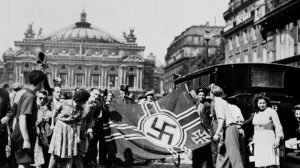
Place de l’Opéra, Paris – August 1944
From their studios near to Opéra Garnier in Central Paris, a group of young graphic artists led by Philip Apeloig became fascinated by the styles and artistic variances of the numerous plaques around their city.
They were astonished to find that there was no register of the hundreds of stone and metal memorials marking the extraordinary events 77 years ago. So they took it upon themselves to photograph and record over 1500 examples from the 1939-1945 period.
Studio Apeloig photographing a memorial plaque in Paris
But the project did not finish there, and new plans to build upon this extensive work are being prepared for a new type of art installation in 2021.
People are getting involved to ensure that the events which happened in today’s busy streets during World War 2 continue to be remembered and research into the backgrounds of the simple words etched in these cold stones detail the events and personal sacrifices behind them.
Simple memorials witnessing the tragedies of War and Occupation.
Whilst Paris did not suffer the intense bombings and destruction like other European capitals during World War Two, its population paid a high price during its Occupation by Axis Forces in terms of deportations, executions, depravations, slave labour and barbaric treatment both by the NAZI’s and France’s own Vichy Regime.
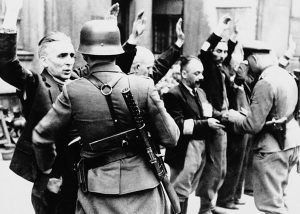
From the day German soldiers marched across the border and into France in May 1940, civilians took a stand against the invaders, and resistance groups began to form. In June 1940 Yvonne Oddon, Boris Vildé and Anatole Lewitsky formed a group at the Musée de l’Homme opposing the NAZI’s and the new Vichy Government.
The group quickly grew to around 100 members who helped refugees, collected intelligence for London, enabled escape routes to be formed and published underground newspapers like “Résistance” and “Vérité Français”. Nevertheless, passive, non-violent resistance was not tolerated by the Occupying Forces and severe penalties were meted out to those involved.
A young 28 year old engineer, Jacques Bonsergent became the first French civilian “resistant” to be executed by the Germans on 23rd December 1940 – his name today remembered in a square and at the metro station on Line 5 in Paris.
The traditional Parisienne street name and the modern Metro Station plaque
Exactly one year later in June 1941, as the NAZI’s turned their attention towards their erstwhile Soviet ally, the Communists in France began to take a more violent attitude towards their new enemies which, in turn, quickly resulted much more harsh and brutal reprisals.
As the War continued the Vichy Government allowed young French citizens to be removed for forced labour in Germany and acquiesced to the internment, deportation and, in most cases, the death of tens of thousands of French citizens in concentration camps across Eastern Europe.
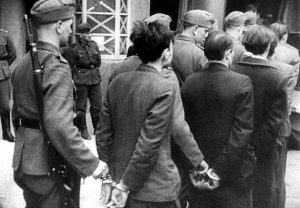
The plaques generally remember the end of a person’s life, being either a Resistant executed or shot dead at this spot or the place where, many Jewish men, women and children, were singled out by the oppressive regime and were rounded up and transported, mostly in terrible conditions, to their ultimate deaths in the NAZI concentration camps.
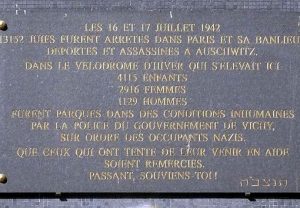
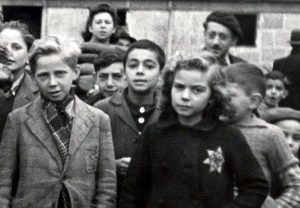
The Nazis deported 166,000 people from France to concentration camps including 76,000 Jews, (11,000 children). The remainder were mostly members of the Resistance.
Forms of resistance within France appeared immediately but were politically and geographically varied with little uniformity other than that of dissent. This patchwork approach was sometimes divisive and led to early discoveries of resistance groups by the Vichy Police and Gestapo. With support from Britain and the new Free French Government established by General De Gaulle in London, groups were gradually brought together within networks and in the main, politics were laid aside to concentrate on the prime objective to effectively liberate France.
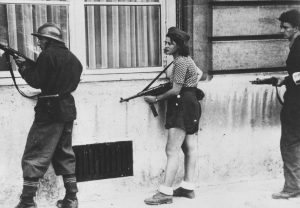
Simone Segouin travelled from Chartres to fight with the French Resistance in Paris 1944
Most streets throughout the capital have a story to tell and hundreds of plaques, often in obscure places, throughout the city, silently record the place where a human tragedy occurred. Probably amongst the highest number of such memorials in any city in the world.

A large number of these memorials record the events surrounding the last days and hours of enemy occupation and the massed civilian uprising toward a perceived weakened but nevertheless well-armed professional army, which inevitably led to tragedy.
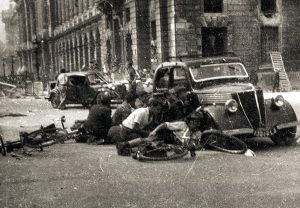 Place de l’Hotel de Ville, Paris – 25th August 1944
Place de l’Hotel de Ville, Paris – 25th August 1944
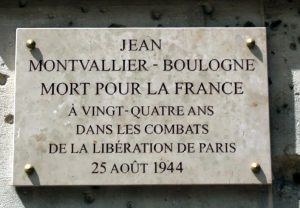
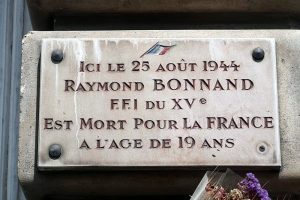




Other memorials remember British, Canadian, Australian, USA and many other nationalities either civilian or military who ended their days in the streets of Paris, fighting for the liberation of Europe.

AVRO Lancaster bomber No. LM336 of No. 57 Squadron RAF East Kirkby, Lincolnshire returning home from a mission against the armaments factories in Mannheim. This was the four Canadians first mission having just arrived in Britain on 05/09/1943.
The plane was hit by gunfire in the Le Pré Saint Gervais neighbourhood. It completely exploded and the fuselage hit the Louvre Department Store. One engine fell in front of 14 Sauval Street, another engine crashed down the stairs of a building in front of 49 Rue de L’Arbre Sec, the wing and another engine fell on Rue Saint-Honoré. One of the crew members fell on the balcony of the 4th Floor of 20 Rue du Louvre, another fell into the courtyard of the Louvre Museum, and four were found on Rue Saint-Honoré. The pilot was found with the fuselage of the aircraft, still at the controls. The young pilot (Joe Hogan) was training to be a banker with the Bank of Nova Scotia. One was Australian and two were British. They are buried at Clichy Northern Community Cemetery.
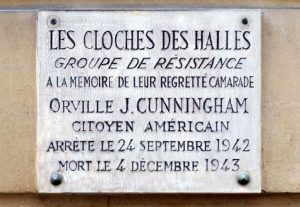

A member of “The Bells of Les Halles” Resistance Group, American, Orville Cunningham was captured and executed by the Nazi’s on 4th December 1943. He was 50 years old.
Of the 130 members of this group 17 were KIA, 11 were executed and 33 deported (of which 23 died).
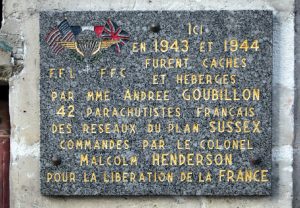
“Operation Sussex” was a highly secret Anglo/French/US mission to infiltrate enemy occupied areas before and after “D-Day” in order to obtain intelligence regarding German troop movements, strengths and Resistance members who could help. This group of 42 “parachutists” located in Paris and hidden at great risk “by Madame Goubillon” was to gather information especially from the German Military Intelligence Service (Abwher) located at the Lutecia and Majestic hotels. By this time any special troops that were captured in German occupied areas, whether in uniform or not, would be executed immediately.
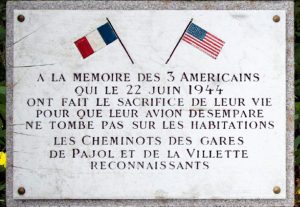
This B.17 “Flying Fortress aircraft (No. 42-102552) was named “Horn’s Hornet” after its pilot Lt. Jay Horn and was delivered to USAAF Cheyenne Field, Wyoming, USA in March 1944 and then to 339 Bomb Squadron, 96 Bomb Group, 3rd USAAF Air Division based at RAF Snetterton Heath near Thetford in Britain.
On 22nd June 1944 it’s target was to bomb enemy targets at Nucourt, 40 miles (64 km) North West of Paris but was hit by German anti aircraft guns and crashed at Rue Payol/Rue Ricquet in Paris.
There were 10 crew members and only 3 survived. The co-pilot, navigator, bombadier & radio operator jumped by parachute but the co-pilot’s parachute failed to open and he was killed, landing at 5 Rue Lecuyer, St. Ouen in the northern suburb of Paris near the Peripherique. The pilot, Jay Horn, and gunners were all killed in the aircraft, and the survivors were taken prisoner. Radio operator Frank Cowan passed through several camps including Buchenwald.
Today many people pass by and do not notice the memorials, except perhaps on the rare occasion when a small bunch of flowers appears beside a plaque, laid there by an unknown person. Perhaps a relative, an aged veteran or someone who still remembers and cares.

Yvette Feuillet was born on January 25, 1920, and lived in Paris with her mother and her sister Henriette. Her father, a baker, had died in 1930. Yvette worked as a glass blower at the electric lamp factory on Sedaine Street near the Bastille and in 1937 the family moved to 26 rue des Rosiers. When the Occupation began both sisters joined the Resistance, but Henriette was arrested on 8th October 1940 by French police who searched their home. She was imprisoned in the notorious Santé prison.
Yvette continued working for the Resistance of the National University Front but on 2nd March 1942, she too was arrested and interrogated, and on 23rd March 1942, she was handed over to the Gestapo. On 22nd January 1943, she was transported via Compiègne and crammed onto four railway cattle trucks with more than 1,700 other prisoners. In Germany, the men were diverted to Sachsenhausen and the women to Auschwitz, where they arrived on 26th January. Next morning, still in the trucks, they are removed and made to walk to Birkenau Camp where they arrived singing “La Marseillaise”.
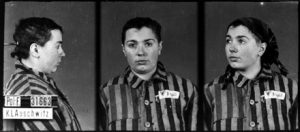
The last photographes of Yvette Feuillet taken at Auschwitz in 1943
Yvette was tattood with the number 31663 on her left forearm and on 3rd February, she was returned to Auschwitz-I and photographed with shorn hair and striped prison clothing. By April 1943 she had suffered severe frostbite on her ankles which became infected with typhus and she died on July 6, 1943.
An inmate recorded that Yvette “can’t talk because she’s in so much pain. She looks at me and I listen to her stammer slowly, very slowly”.
Yvette Feuillet was officially named as a sergeant FFI (Forces françaises de l’Intérieur) and posthumously awarded the Order of the Resistance – she was just 22 years old.
Many plaques record events and people who made a difference.
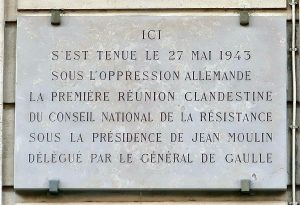
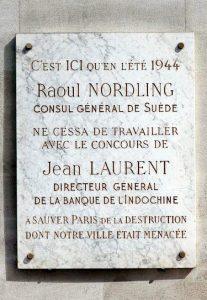

Notable dates and personalities include: Jean Moulin’s first meeting with the Resistance in Paris; the Swedish Consul & the bank director who persuaded the German Commandant of Paris not to obey Hitler’s orders to destroy the City’s famous landmarks; and the American jazz singer who aided the Resistance and undertook covert intelligence gathering for the Allies.
After 77 years since the City was liberated in August 1944, many of the plaques of various colours, dimensions and designs have generally faded into the background with the passing of time and the installation of modern new signs and shop fronts standing out brightly from the grey marble and stone of the wartime plaques. But, without these memorials it would be easy to forget the major events which took place in these very streets.
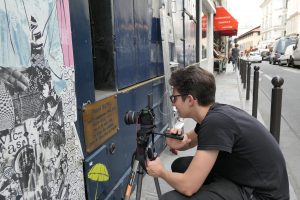
Philippe’s team began the long process of locating the plaques from information obtained from the Paris Directorate of Cultural Affairs, from Holocaust Memorial Archives, books and other resources, as well as simply spotting them throughout the hundreds of streets in the City.
Photographing the plaques was not always as simple as it seemed
The work to identify, photograph and record them took over 4 years and the results were not easily obtained as many plaques are high above street level and have suffered over time from the elements. Recording the images was sometimes precarious and it is poignant that the ages of the graphic art team are not so different to those who fought in the streets 77 years ago.
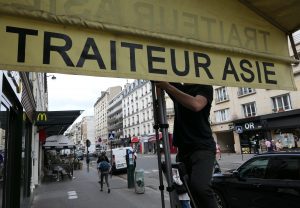
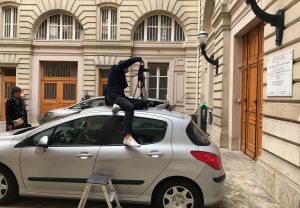
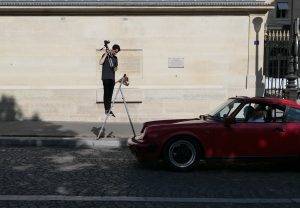
Apeloig Studios Production Team
Click here to see a short video of the recording process: 11.01.05.2018-ENFANTS_DE_PARIS_MK2_MAKING_OF_PARTIE_3
The result of this initial work has been the publication of an excellent book containing the photographs of the plaques and showing the different styles. Philippe called the book “Enfants de Paris 1939-1945”, in a reference to the film “The Children of Paradise” by Marcel Carné, shot during the Occupation in Paris, whose story takes place in Paris as reconstructed in hiding by the Jewish decorator Alexandre Trauner.
The title is also an acknowledgement to the opening lines of the French National Anthem (Allons enfants de la Patrie...) and honours the memory of the many people who paid with their lives. This extraordinary record received the Thiers 2019 Prize from the Académie Français and is beautifully designed and presented.
Copies can be obtained here: http://www.gallimard.fr/Catalogue/GALLIMARD/Hors-serie-Connaissance/Enfants-de-Paris
Whilst the initial reason for the project and its subject matter is art, showing the designs, lettering, character fonts, differing layouts and graphic diversity of these particular urban typographies, it has clearly aroused a realisation that the stories, which each individual plaque represented, were significant moments in the history of the City which were quickly fading and should be maintained. The significance of each one is a reminder of the huge price that individuals of many nationalities had to pay to maintain the freedoms which the city (and Europe) enjoy today.
Stage II – The Art Installation “Those walls that beckon us”
The next stage of the project, which as Philippe says, “is a crossroads between art, memory and education”, is to create an art installation “Those walls that beckon us“. However, the current pandemic restrictions severely impact upon such an idea, so permission has been granted to project the images of the plaques by laser scanner onto the exterior walls of the Pantheon building – France’s great mausoleum, for all to see whilst maintaining safe “social distancing”.
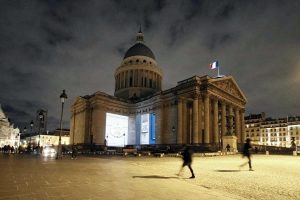
An impression of how the art installation would look.
The 18th century Pantheon built in the Latin Quarter at Montagne Sainte-Geneviève, Central Paris. The grand mausoleum of famous French notables from history.
Already French, German and Polish organisations have already promised their support but more is required. Because many of the plaques relate to allied countries, involvement from Britain, USA, Canada and Australia is welcomed. Further support is required to complete the project which includes drone filming of the art installation and production of a public information leaflet & educational leaflet, which will ensure the names behind the plaques are centrally recorded and that future generations will no longer just pass them by, but appreciate the sacrifice made to ensure their freedoms.
Current supporters of this project include: Centre des Monuments Nationaux; Office Franco/Allemand de la Jeunesse; Ministère des Armées; Fondation Rothschild – Institut Alain de Rothschild; Institut Polonais de Paris; Laurent Dassault. If you can help or can suggest a way of helping complete this important project please contact: info@afheritage.org or info@apeloig.com.
“Children of Paris” – Allied Forces Heritage Group
Story: Ian Reed
French Translation: Geneviève Monneris
Aircraft Research: John Larder
LATEST NEWS:
May 2021 Connexion – https://www.connexionfrance.com/French-news/Pantheon-lights-up-for-France-s-ordinary-war-heroes
May 2021 Franceinter Radio interview: https://www.franceinter.fr/emissions/une-journee-particuliere/une-journee-particuliere-09-mai-2021
Feb 2021 Anglo/French newspaper Connexion –
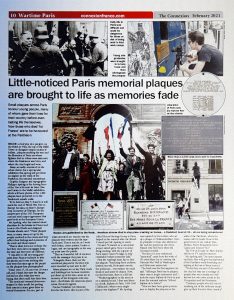
Mar 2021 A full scale test took place on 24 March of the art installation at the Pantheon in Paris to commemorate those who took part in the liberation of France and in particular Paris. The socially safe installation will be available to see on 17, 18 and 19 September:
17 September 2021
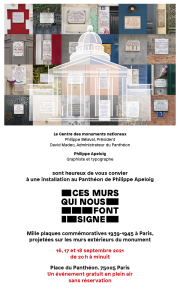
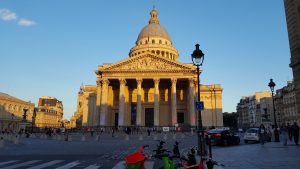

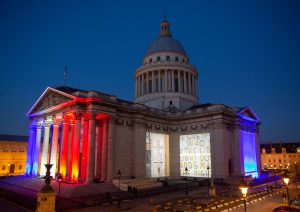

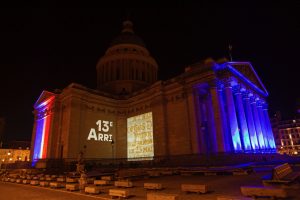

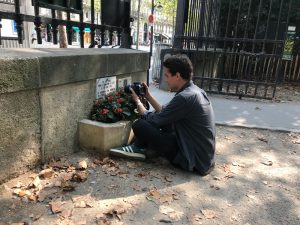

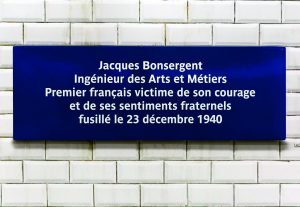
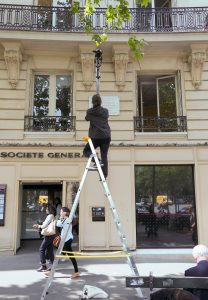
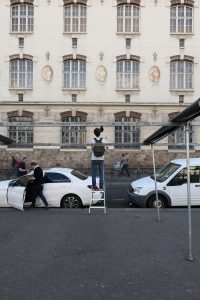
What a brilliant idea. Bravo!
Excellent. Long overdue. Thanks to those involved in this project & those real heroes commemorated.